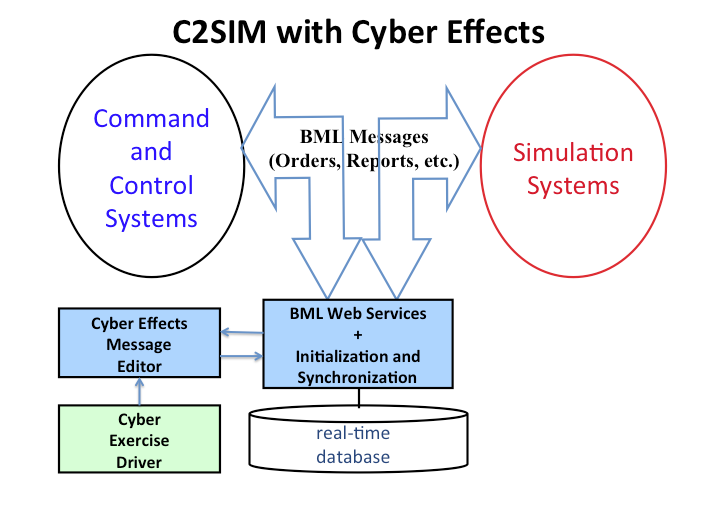
Recent Activities Papers and Presentations Software Architecture Video
C4I & Cyber Center projects have coordinated and supported NATO and SISO projects in Command and Control – Simulation Interoperation (C2SIM). The C2SIM-Cyber project adds to the C2SIM server the ability to impress Cyber effects on C2SIM messages as they pass through the server, to support effective Army operational training in environments where Cyber attacks may occur.
BML: Technology for unambiguous communication among Command and Control (C2), Simulation, and Robotic systems in support of interoperability. GMU is a leader in development of standards and servers, working with NATO MSG-085 and SISO Military Scenario Definition Language (MSDL) and Coalition Battle Management Language (C-BML).

Battle Management Language (BML) began in work sponsored by the US Army’s Simulation-to-C4I Interoperability Overarching Integrated Product Team (SIMCI OIPT). Its purpose was to show the feasibility of defining an unambiguous language, based on manuals capturing the doctrine of the US Army.
The XBML project, part of the XMSF initiative, was built on the original Army work. Its two main objectives were: (1) using Service Oriented Architecture (SOA) technology for information exchange among the systems’ interfaces and (2) using the MIP’s Command and Control Information Exchange Data Model (C2IEDM, an earlier version of the JC3IEDM) as a basis to represent the information to be exchanged between the systems. It also served as the basis for an international experiment that led to MSG-048. (See below.)
The next step was Joint BML (JBML), which expanded into the Joint arena by including ground, air and maritime domains as well as urban warfare. JBML achieved considerable technical progress by creating a revised Web service schema, based on lexical grammar and designed to facilitate expansion into other military realms. Considerable work in Coalition BML (C-BML) has grown from these results.
Integrated BML (IBML) was developed in 2009 and was a first attempt to standardize BML. A somewhat later version IBML09 is used by a number of clients. IBML09 is also the basis for an extended version developed at the Fraunhofer Institute (FKIE).
The Simulation Interoperability Standards Organization (SISO) has standardized the Coalition Battle Management Language (C-BML) after development for the past several years. C-BML exists in two dialects, Full C-BML which expresses a full implementation of JC3IEDM and C-BML-Light which contains the elements most commonly used by most command and control systems and simulators. C-BML-Light is based on IBML.
The GMU C4I Center has produced several versions of BML servers.
-
Some of the functions of all BML servers are:
- Reception and validation of BML documents
- Translation between different BML dialects
- Distribution of documents to subscribers
- Processing queries for documents previously received that have been saved in the server
- Logging of BML documents received during a simulation session and replaying them with time synchronization
The servers interface with clients using a WebServices interface. The early servers only presented this interface and required queries in order to receive reports. Later servers implemented a publish/subscribe capability allowing reports to be received asynchronously.
The first generation BML server was implemented entirely in Java / JAXB and provided SOAP based web services.
The second generation BML server was written in Java and implemented in JBoss (4.2.3). This server was known as the Scripted BML (SBML) server. Specific BML processing and mapping to the JC3IEDM database was provided by a scripting language known as CSL. This enabled the specification of the source of data fields and the table and column in the database along with other processing of the data.
The third and current version WISE-SBML is based on SAAB’s Widely Integrated Systems Environment (WISE) an online software framework produced by SAAB defense systems. The BML implementation is implemented in C++ and runs under WISE on a Windows 7 server.
-
This server supports the following client interfaces:
- RESTful Web Services
- STOMP based publication subscribe services
- A java client library as well as standalone pub/sub and RESTful WS clients are provided.
Processing of and translation between the following BML dialects is provided.
- IBML 2009
- IBML Fraunhofer-FKIE Variant
- C-BML Light
- C-BML Full
The initial capability was demonstrated on the SAAB 9LAND BMS Tactical Command and Control System. (See a more detailed description of the WISE-SBML implementation). The public WISE-BML source code developed by the GMU C4I Center (test version) can be found in the C4I Open BML wiki. An installation and operations document for the WISE-SBML server can be found here. This wiki has the C++ code and .h file but doesn’t contain any of the proprietary WISE software. However, it requires a running Saab WISE system in order to work.
NATO CSO Modeling and Simulation Group (MSG-048) found that Coalition operations have a need for interoperability that is even greater than that of national Service and Joint operations. The agility to train and rehearse rapidly before the actual operation is highly important.MSG recognized this need and chartered Technical Activity MSG-048 to explore the promise of C-BML. (2005-2009)
In April 2013, MSG-048 Coalition Battle Management Language was awarded NATO’s annual scientific achievement award. The C4I Center was a key participant in this NATO Technical Activity. Individuals named in the nomination were Michael Hieb, Douglas Corner, and J. Mark Pullen.
The Modeling and Simulation Group (MSG-085) was chartered by the NATO MSG to extend the investigation of C-BML, which now includes the Military Scenario Definition Language (MSDL), in order to assess its operational relevance and to assist in increasing the Technical Readiness Level of Coalition BML technology to a level consistent with operational employment by stakeholders, while also contributing to C2-Simulation standardization. (2010-2013)
The MSG-085 conducted a demonstration at Fort Leavenworth in December 2013 using the WISE-SBML server as well as other BML servers and a number of C2 and simulation systems.
Recent Activities Papers and Presentations Software Architecture